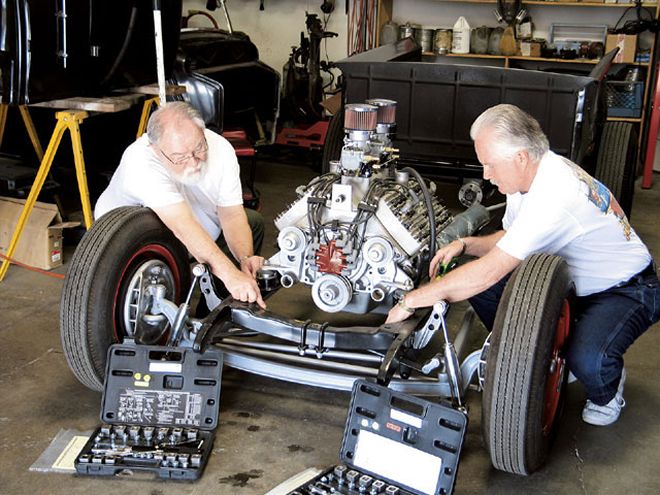

Building a street rod is a rewarding experience, particularly when you get to drive the end result, but there are also some sobering realities involved in assembling an automobile from the ground up. First off, despite what you may see on TV, it takes more than a couple of weeks for the average person to do it. Secondly, you and your loved ones will be riding in it, so the importance of building a safe car above all else can't be overstated. One of the tasks involved in street rod construction that is both time-consuming and critical to functionality is plumbing. Last month we looked at the variety of fittings commonly used, so this time around we're going to give you a few tips and tricks on how to hook them together.
Brake Lines
First let's deal with a common misconception-the relationship between brake line size and hydraulic pressure. Simply put, there is no relationship. The master cylinder establishes the pressure in a brake system; all the lines do is deliver the pressurized fluid.
Brake lines are most often 3/16- or 1/4-inch-diameter and, while there will be no pressure difference between the two, there will be a difference in the amount of fluid delivered. The bigger tubing will carry more volume, so 1/4-inch line may be preferable in some instances (four-wheel disc brakes being an example).
Regardless of the size, when it comes to selecting the type of rigid brake lines to use, there are only two choices: steel or stainless steel. Copper or aluminum should never be used. And Gary Clausen of Pure Choice Motorsports points out that excessively long lengths of flex line, including the braided variety, should not be used, as a spongy pedal will result.
One of the most common mistakes made when plumbing a chassis has to do with routing; brake and fuel lines should be a minimum of 3 inches away from any significant heat sources, most notably the exhaust system. And while it's a little off the subject of plumbing, we have to mention the problems associated with positioning the exhaust pipe too close to an underfloor master cylinder. It is very common for these components to be quite close, but be aware that a master cylinder, and the fluid it contains, will readily absorb heat. We've seen instances where the proximity of the master cylinder to the exhaust was such that the fluid would get hot enough to expand and make the brakes drag, or in the worst-case scenario, not release after being applied. If you opt for an underfloor master cylinder and the exhaust pipe is anywhere in the area, consider fabricating some sort of heat shield.
Another important consideration when plumbing a chassis is securing the lines. Clausen recommends using clamps every 18 to 24 inches for adequate support. Putting bends in lines cause them to be more rigid, but too many clamps isn't the problem that too few are. But while the goal would normally be to hold a line secure, there are cases where movement is necessary. Take, for example, firewall-mounted master cylinders. There is usually some movement between the body and frame, so that needs to be taken into consideration when installing the lines. One method is a short flex line between the body and frame. Another is what's called a vibration loop. Clausen recommends putting several coils in the line to provide the needed flexibility.
Flex Lines
When measuring for flex lines it is critical that suspension travel and wheel movement are taken into consideration. The front wheels must be able to turn lock-to-lock and both axles must be able to go through full suspension compression and rebound without putting stress on the hoses. More than one rodder has checked compression travel then jacked their car up only to find out the hoses weren't long enough when the wheels dropped.
Fuel Lines
Many of the considerations concerning the placement of brake lines apply to the fuel system as well. And while steel and stainless steel are the recommended materials for hard lines, aluminum tubing is sometimes used for fuel.
Aluminum tubing is light-that's why it's often found on race cars-but it chafes easily and needs more support than steel or stainless steel. For most carbureted applications, 3/8-inch line is adequate, although high-horsepower engines may require 1/2-inch for enough volume.
When plumbing the fuel system, keep in mind that today's gasoline additives (including alcohol) will cause conventional hose to deteriorate. Plan on replacing any rubber hose in the system every two years, or bite the bullet at the outset and buy the best braided hose with an inner liner you can find.
Ready, Set, Plumb
Before you begin to plumb a street rod chassis, here are some suggestions from the experts at Pure Choice Motorsports:
Identify the type of plumbing you want to use (stainless steel or steel).
Match the fittings to the type of flare used: AN fittings use 37-degree flares, SAE use 45-degree, double-inverted flares.
Use quality tools for installation to prevent rounding off fittings.
Do not over-tighten fittings. AN fittings should be snugged finger-tight then tightened approximately a quarter-turn. While 45-degree fittings require slightly more torque to seal, over-tightening should still be avoided.
Use anti-seize on all aluminum-to-aluminum or stainless-to-stainless fittings.
Use sealer on pipe threads with the tape or sealant starting on the second thread to keep from contaminating the system.
Keep all lines as far away from heat as possible.
Take a look at the photos for a few more tips and tricks on plumbing a chassis.